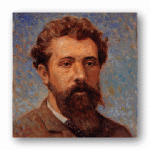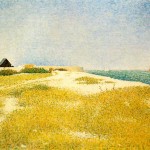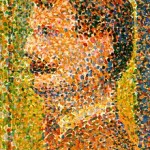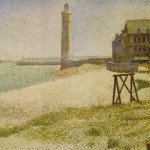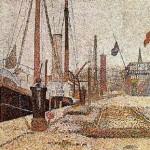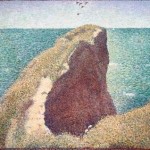Mention George Seurat’s name and the first thing that comes to mind is his “pointillism” his painted pictures of divided color. His Applying paint in regular small strokes giving a picture a look of national order and a new Neo-Impressionism style. Seurat had been born on December 2, 1859 to Ernestine Faivre, and Antoine Seurat. Seurat was the third child in the family.
While attending school, Seurat took a course from a sculptor Justin Lequin. In November 1879, Seurat went to Brest to do his military service. While there he drew beaches, seas, and boats. In 1883, Seurat began Une baignade, Asnieres or a s its called now “The Bathers”. Seurat did many study paintings for the peace, including “the Riverbanks”, “Rainbow”, “The Black Horse”, “Bathers in The Water”, “Seated Bather”, and finally “the Study for “the Bathing Place, Asnieres”.
When he submitted his painting to the official Salon in early spring 1884, it was rejected for reasons unknown. In 1884 Seurat issued another painting Une Dimanche a la Grande Jatte or translated “A Sunday Afternoon on the Island of La Grande Jatte”. Seurat made twenty-seven drawings, twenty-seven panels, and three canvases relating to the final product.
When a viewer gets close to La Grande Jatte the brushwork appears quite varied and animated. The strokes vary from small dots. On the tree trunk the marks change direction and move outward on the branches. The strokes follow the imagined reality of the figures, flowing outward for curves and hips, vertically for upright torsos, and follow the direction of legs.
When the painting is viewed from an affair the brushwork appears in uniform. Seurat found out that when he put dots of blue beside dots of yellow they looked green from far away. Seurat also found out that when he added the complementary color the object became alive with color that shimmered, glistened, and glowed. In 1885 Seurat spent several weeks painting seascapes along the Channel coast staying in Grandcamp. Seurat only made six paintings and only considered one of them finished “boats corner of a harbor”.
In 1886 Seurat finished Poseuses. This painting was Seurat’s nudes. This was Seurat’s last composition on the grand scale of the Baignade and La Grande Jette. The figures in the piece are said to be of the same person, since the proportion is the same. Seurat again made many sketches and paintings relating to the final piece. In 1886 Seurat’s work became focused on the night scene. Seurat painted cafes, concerts, fairgrounds, and circuses. On February 16, 1890 his mistress Madeleine Knobloch who was 21, presented him a son, whom he named Pierre-Georges Seurat.
During that year, Seurat completed Le Chahut which was a nightclub scene with men and women dancing. Seurat’s second to last painting was the Jeune Femme se poudrant which was a portrait of his mistress. The portrait gave his mistress a Goddesses like appearance in which made her look huge. Seurat had a second child with Madeleine but shortly died after birth. Seurat’s final work was Le Cirque which was a painting of a circus scene. the picture shared the same elements as of the Chahut in that both had an audience and performers.
Seurat used a grid technique in order to blow up the smaller compositions in which he had drawn. On Easter Sunday 1891, Seurat died of infectious angina. Shortly after Seurat’s son, Pierre-Georges Seurat contracted his father’s illness and died on April 13, 1891. Seurat was once asked If his work was done mechanically? Seurat replied “No, Monsieur, by hand”.



